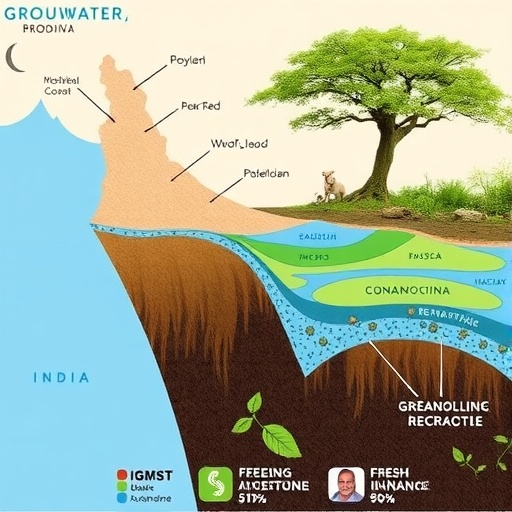In the increasingly precarious balance between freshwater availability and saline water intrusion, a groundbreaking study has emerged from the eastern coast of India, shedding new light on the complex dynamics governing coastal aquifers. This fresh research delves deep into the interaction between fresh groundwater and surrounding saline waters, offering critical insights that resonate far beyond the regional scope and could redefine how water resources are managed in coastal zones worldwide.
Coastal aquifers, natural underground reservoirs, have long been recognized for their crucial role in sustaining human populations, agriculture, and ecosystems. However, these vital water stores face mounting challenges as rising sea levels, increased groundwater extraction, and climatic variability converge, threatening to accelerate the encroachment of saline water into freshwater zones. The research conducted by Goswami and Rai confronts this pressing issue head-on through a meticulous case study on India’s east coast, a region characterized by both dense population and pronounced vulnerability to environmental stressors.
At the heart of their investigation lies the fundamental hydrological interplay between fresh and saline groundwater within coastal aquifers. The study applies state-of-the-art modeling techniques and empirical data to unravel how these two water types interact beneath the surface. Findings reveal that the interface or mixing zone between fresh and saline water is far more dynamic than previously thought, shaped by a delicate equilibrium between natural recharge, human extraction, and tidal influences. Understanding this equilibrium is pivotal for sustainable water management in coastal regions where saline intrusion can compromise entire aquifer systems.
The study utilizes advanced geophysical surveys and continuous monitoring of groundwater levels and chemistry to paint a precise picture of how saline water moves inland and how freshwater pushes seaward. Such detailed monitoring is crucial for anticipating shifts in the saline-freshwater boundary, enabling early intervention to prevent irreversible contamination. This knowledge is particularly vital given the projected scenarios of climate change that predict further sea level rise and altered rainfall patterns, both of which exacerbate saline intrusion risks.
Additionally, the research highlights the role of anthropogenic activities in accelerating the dynamics of saline encroachment. Intensive groundwater extraction for agriculture and urban water supply reduces the hydraulic head of freshwater aquifers, effectively creating a pressure gradient that invites saline water migration landward. This process, often invisible until critical thresholds are breached, underscores the need for integrated water resource management that accounts for subsurface hydrodynamics and human demands in tandem.
Beyond the physical mechanisms, the study also explores the geochemical transformations occurring within the aquifer as fresh and saline waters interact. Mixing leads to chemical exchanges that can alter water quality, precipitate mineral dissolution or formation, and impact the aquifer’s storage capacity. These subtle but impactful changes demand attention as they influence both the usability of groundwater and the broader biogeochemical cycles within coastal environments.
One of the hallmark achievements of this work is the development of predictive models calibrated with extensive field data, enabling scenario-based projections. These models simulate future conditions under various recharge rates, extraction intensities, and sea level rise parameters, providing water managers with essential tools to evaluate the effectiveness of different mitigation strategies. Such foresight is indispensable in crafting adaptive policies that safeguard freshwater resources in the face of inevitable environmental changes.
The implications of these findings extend well beyond the east coast of India. Coastal regions globally grapple with analogous challenges; thus, the research offers a template for assessing and managing groundwater salinization risks elsewhere. By contextualizing the hydrodynamic and geochemical interactions specific to their study site, Goswami and Rai demonstrate the feasibility and necessity of localized approaches embedded within a broader framework of coastal groundwater sustainability.
Moreover, the study brings into sharp focus the potential feedback loops between natural processes and human interventions. For instance, groundwater pumping not only draws down freshwater levels but can also influence tidal flows and sediment transport, which in turn affect aquifer recharge and saline water intrusion patterns. Recognizing and quantifying these feedbacks is essential for anticipating unintended consequences that might otherwise thwart conservation efforts.
This research arrives at a moment of heightened global awareness regarding water security amidst climate change. The nuanced understanding it provides about salinity dynamics enriches the arsenal of scientific knowledge needed to confront water scarcity challenges, particularly in vulnerable coastal zones where millions depend on fragile aquifers for survival and economic activity.
Critically, the study underscores the urgency of combining field observations with innovative modeling to capture the spatiotemporal complexity of groundwater systems. Such integrative research paradigms empower stakeholders—from local water managers to international policymakers—with data-driven insights necessary for sustainable resource allocation and emergency response planning.
Furthermore, the article draws attention to the importance of cross-disciplinary collaboration. Addressing the intricacies of fresh-saline water interactions demands expertise in hydrology, geology, chemistry, environmental engineering, and socioeconomics. By successfully integrating these facets, the study sets a benchmark for future inquiries into complex environmental systems.
In conclusion, the investigation by Goswami and Rai not only advances scientific understanding of coastal aquifer dynamics but also offers practical pathways for mitigating the adverse impacts of saline intrusion. Their work exemplifies how rigorous science can translate into actionable knowledge, enabling communities and governments to protect and optimize precious groundwater resources in an era of escalating environmental uncertainty.
The reverberations of this research promise to influence water management paradigms, inspire further studies, and ultimately contribute to the resilience of coastal societies facing the twin pressures of population growth and climate change. In doing so, it reaffirms the vital role of sustained, detailed scientific inquiry in safeguarding the planet’s most invaluable natural resources.
Subject of Research: Interaction dynamics between fresh and saline groundwater in coastal aquifers.
Article Title: Dynamics of fresh and saline groundwater interaction in coastal aquifers: a case study from the east coast, India.
Article References:
Goswami, S., Rai, A.K. Dynamics of fresh and saline groundwater interaction in coastal aquifers: a case study from the east coast, India. Environ Earth Sci 84, 516 (2025). https://doi.org/10.1007/s12665-025-12488-7
Image Credits: AI Generated




